During the pandemic, many people hunkered down and explored the art of making bread for the first time. Some used dry active yeast or baking soda to find that perfect rise, while others dabbled in the wild world of sourdough starters.
But home bakers didn't just learn about making bread in its most natural form – they tapped into living antiquity. Sourdough starters, often referred to as mother dough, have a nearly 6,000-year history that spans the globe and are responsible for feeding the planet millions of times over.
This captivates bread-makers, scientists and researchers who want to understand how this elixir of life came about and what makes it so special – especially when the starter's owner claims a long and storied history. Because of this fascination, old starters have an almost mystical quality to them, and finding them and baking with them have gripped home cooks and professionals around the world.
The search for the oldest sourdough starter spans continents and countries, science labs and libraries, and involves everyone from the Ancient Egyptians to Jesus Christ. This is a quest to find the oldest mothers on the planet – living, breathing, bubbling sourdough starters that helped build the pyramids, fed the Roman Empire and nourished a gold rush.
For the uninitiated, sourdough bread is made with a sourdough starter. A starter is a leavening agent that helps the bread to rise when it's baked. In its simplest explanation, a starter is formed when you combine water and flour and allow natural yeasts and bacteria that are floating around the air to combine and begin to ferment. Over time, the yeast will consume the carbohydrates in the flour and convert them into carbon dioxide, which is what gives sourdough its bubbles.
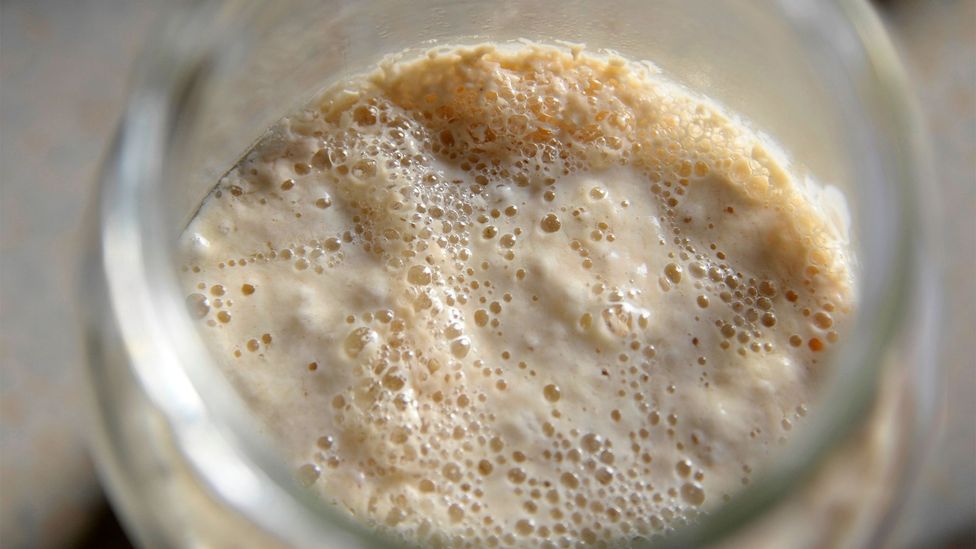
Yeast consumes carbohydrates in flour and converts them into carbon dioxide, giving sourdough its bubbles (Credit: Grahamphoto23/Getty Images)
Like yeast, the bacteria also consume carbs, but instead of bubbles, its by-product is lactic acid, which puts the sour flavour in sourdough. The result is a living organism that's tantamount to a pet that requires feeding and care with water, flour and friendly growing temperatures.
Like the bubbling sludge of a fermenting sourdough starter, the history of making sourdough bread is murky. According to historians and archaeologists, widespread breadmaking really took off around 5,000-6,000 years ago in Ancient Egypt. You can find hieroglyphics of farmers collecting wheat and baking loaves all over tombs and temples. But were the Egyptians using a starter?
According to Dr Serena Love, a gastro-Egyptologist, it's not proven. "During the pyramid age, so 2,500 BCE, when the pyramids around Giza and that whole complex were being built, what we have is textual sources that says [workers] were given a daily allowance of bread, beer and onions. And when you're talking about 10,000 people that were living there, you are making a lot of bread."
While it's unknown whether the Egyptians were deliberately using an actual starter to make their bread, the bakers at the time might've stumbled on the way to use some of the flour/water mixture from the day before and put it into the next day's bake. So, according to Love, "You could call it a sourdough, they're making bread, and then they'll take a bit [of dough] and use it for the next batch… They're still learning how to do this on a massive scale though."

Hieroglyphics of farmers collecting wheat and baking loaves can be found on tombs and temples in Egypt (Credit: Album/Alamy)
For actual proof of sourdough baking, you have to fast forward a few thousand years to Ancient Rome and read through the texts of Roman historian Pliny the Elder around 77 CE. Professor Eric Pallant, author of Sourdough Culture: A History of Bread Making From Ancient to Modern Bakers, says that this is the first recorded instance of leavening with a bread starter.
"This is what Pliny the Elder is writing down. The Romans are basically saying, you can make bread and you can make it rise. And if you save some [of the dough] from yesterday, you [can] throw it in to today's bread. That's the first written-down recipe where I'm fairly confident," said Pallant.
Gold rush sourdoughs
Sourdough's history can also be traced to the gold rushes of the 1800s in the western United States, Alaska and Canada. Miners were known to keep sourdough starters with them and would sleep with the starters at night to keep them warm for making bread the next day. Rumour had it that they even began to smell like their sour dough and were then nicknamed "sourdoughs" as a result.
Michael Gänzle, a food microbiologist from the University of Alberta in Canada, who has been working on the science of sourdough for more than 20 years, backs up Pallant's research and adds a new ingredient to the mix.
"To my knowledge, the oldest document [that talks about] 'backslopping' is approximately 2,000 years old, and there are two sources. One is Pliny the Elder, who wrote about sourdough and explicitly makes reference to backslopping, which means using a part of the dough of the previous day and making the next sourdough," Gänzle said. "The second reliable source is the New Testament."
If you scour the gospels, you'll found numerous references to leavening, which would require backslopping to make bread. Some examples include Luke 13:20/21: Again He asked, "To what can I compare the kingdom of God? It is like leaven that a woman took and mixed into three measures of flour, until all of it was leavened." Or, in Matthew 13:33: "The kingdom of heaven is like yeast that a woman took and mixed into about sixty pounds of flour until it worked all through the dough."
Gänzle continued, "If you look at the story of sourdough [in the New Testament], the way the story is used implies that sourdough was used as a starter culture. And irrespective of what you think of the Bible, the fact that somebody in the 1st Century referred to [leavening]… means that [baking with a sourdough starter] was commonly done at the time."
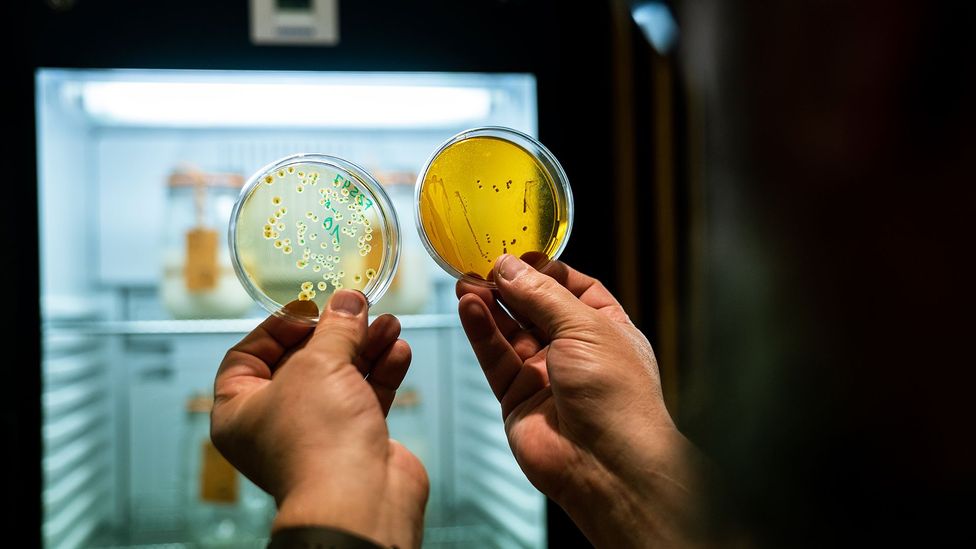
De Smedt is working with Gobbetti to isolate yeast and bacteria strains and freeze them (Credit: Puratos Center for Bread Flavour)
Even though sourdough starters have their histories intertwined with Ancient Egypt and Rome, do any descendants of these original starters still exist today?
Sadly, there is no 23 and Me or Ancestry.com for sourdough. Professor Marco Gobbetti, a microbiologist from the Free University of Bolzano, Italy, is one of the world's leading scientists on sourdough and explains why it's not possible to scientifically prove the age of a sourdough starter. "Today, we are using the most sophisticated tools to carry out this analysis. We can give names to lactic acid bacteria and to yeast, but we cannot understand how old the sourdough is," said Gobbetti. "Why? Since the life of a microbe is lasting not more than one day."
Global microbes
While there are different types of yeast and bacteria that come together to form sourdough, the same microbes tend to show up on every corner of the planet, so it's hard to know where a particular starter originated.
"Younger starters tend to have lactobacillus plantarum or brevis," explained Erin McKenney, an assistant professor in applied ecology at North Carolina State University and part of a team that ran a global sourdough project that analysed around 500 different starters from around the world. "And then older starters tend to have lactobacillus sanfranciscensis (like the one that was initially isolated from San Francisco sourdough), even though we found it is not geographically bound. It's sourdough bound."
But that scientific fact hasn't stopped bakers and sourdough enthusiasts around the world from making wild claims about starters that are more than 100 years old or ones that date to the Middle Ages and beyond.
And there are stories. Like Seamus Blackley, the inventor of the Xbox, who scraped yeast off 5,000-year-old-Egyptian pottery and made sourdough with it. Or the Israeli team led by Ronen Hazan, a microbiologist at the Hebrew University in Jerusalem, who made beer from yeast found in ancient clay vessels. Then there are the sellers on eBay and Etsy who make claims of starters dating to the Black Death or to Silk Road traders more than 900 years ago.
So, if you can't scientifically determine the age of sourdough starters, where does that lead? Inevitably the place where stories are catalogued, which takes this quest to Belgium and the Puratos Center for Bread Flavour – the world's only sourdough library – which is home to some really old and really rare mothers.
The Puratos Sourdough Library, located about 90 miles south-east of Brussels, is run by Karl De Smedt, a baker who is tasked with preserving the world's rarest and oldest sourdough starters. "What we do here is three things. We preserve the biodiversity of sourdough, we protect the heritage, and we offer a backup to those who give us a sample of their sourdough starter," he said.
De Smedt is working with professor Gobbetti, the sourdough microbiologist from Italy, to isolate yeast and bacteria strains and freeze them (which puts the microorganisms in a hibernating state), so they can be preserved in perpetuity. His findings mirror those of the other microbiologists around the world in that similar strains of yeast and bacteria show up everywhere, and there's no way to know how old any of the starters actually are.
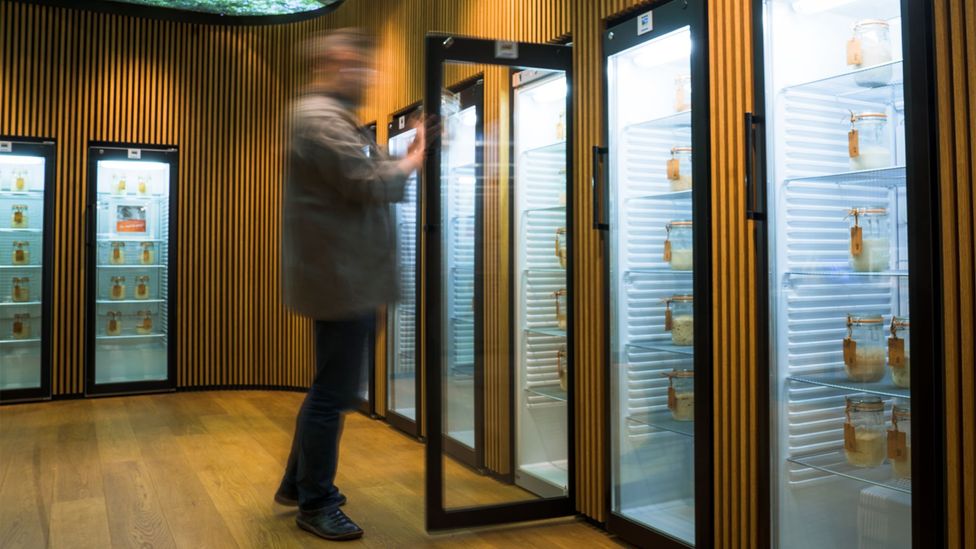
Puratos Center for Bread Flavour in Belgium is the world's only sourdough library (Credit: Puratos Center for Bread Flavour)
"You cannot carbon date a sourdough. When I get a sourdough from someone, I have to trust them, he said.
But just because scientists can't technically find out the age of the starter, De Smedt still believes a few of the starters in his vaults have some age-old merit.
"I have a couple here. One is coming from the Klondike Gold Rush. So, it goes back to 1896. One from Switzerland goes back six generations, and the bakery was founded in 1868. I have another one from Japan, which is from 1875. But they do not come with a birth certificate. So, it's impossible [to be sure]. said De Smedt.
As a true believer in sourdough, and despite the current scientific barriers, De Smedt continues to search for rare and old starters. "The quest for sourdough is to go out and find sourdoughs that are still around and that we could study here in the library. It's very difficult, because what is the rarest? We don't know that yet. I hope to encounter them."
For De Smedt – and many others – the stories behind the starters are perhaps more important than the starter itself.
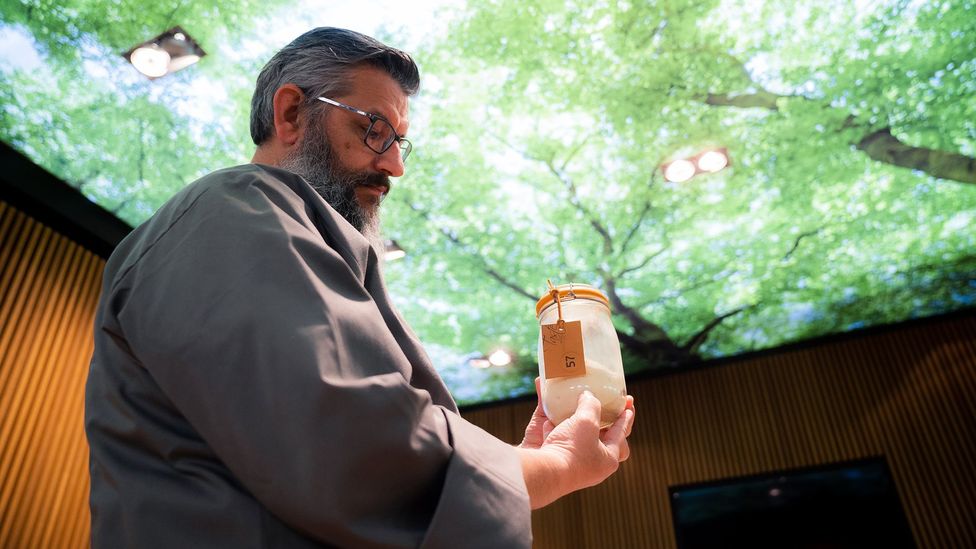
Karl De Smedt preserves the world's rarest sourdough starters at the Puratos Sourdough Library (Credit: Puratos Center for Bread Flavour)
Take Daniele Uditi, a pizzaiolo from Caserta, Italy, who smuggled his family bakery's almost 70-year-old starter to Los Angeles and uses it to form the perfect crust on his neo-Neapolitan pies at his award-winning pizzeria Pizzana.
There's Ione Christensen, an 89-year-old home baker from Whitehorse, Canada, who claims that the crunchy, chewy sourdough waffles she makes at home comes from her starter that dates to the Klondike Gold Rush. "Well, I can trace it back positively to 1898. That was when my great grandfather and his four sons left St John's, New Brunswick, in February of 1898 for the Klondike Gold Rush," said Christensen… And then it's been in our family ever since."
In Japan, the Kimuraya bakery uses a unique starter made with cooked rice, rice malt and water for their An Pan bread they've been making since the 1870s and loved by Japanese emperors and commoners alike.
The famous Italian chef and cookbook author Sara Papa, claims to have a starter from Milan that dates to 1848 and uses it for crackly, fluffy sourdough loaves.
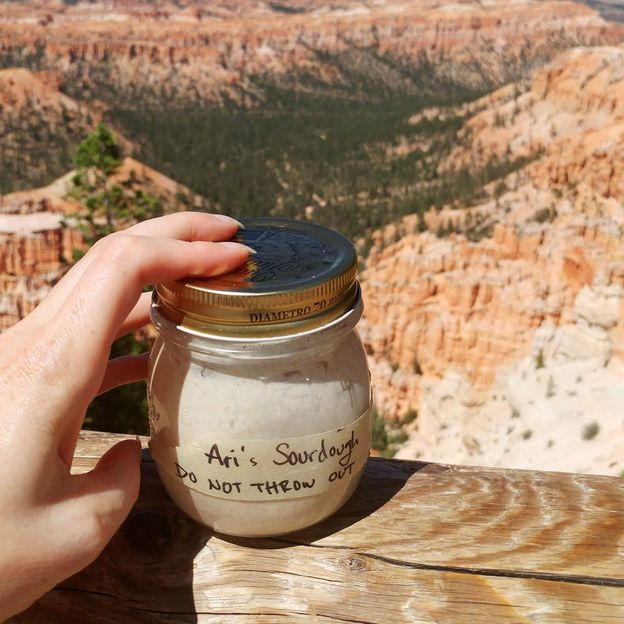
Arianna Sikorski inherited a Klondike Gold Rush starter that's thought to date to the 1890s (Credit: Arianna Sikorski)
And then there's Arianna Sikorski, an Alaskan who inherited a separate Klondike Gold Rush starter that dates to the 1890s and travels all over the world with it, sharing it with fellow bread enthusiasts. "In terms of proof, we don't have a photograph of 1896 when it was first created in a tent somewhere. I can only prove what I saw when I was a kid in the sense that we always had it going. I lived in a cabin, that was our main source of food for quite some time. And my parents had always kept it active and alive," said Sikorski.
The list goes on of family stories and baker origins that are impossible to trace, and all come with their own folklore. But when it comes to verification, only a few have enough data to back up their claims.
"In my world, there are two credible reports for sourdoughs that are more than 100 years old," said Gänzle.
"One would be the Boudin Bakery in San Francisco. They will tell you that they maintain their sourdough since the Gold Rush in 1849. And I think that's perfectly reasonable and credible. Because I do know if a baker hands over the bakery to somebody else in the family or outside of the family, the starter stays."
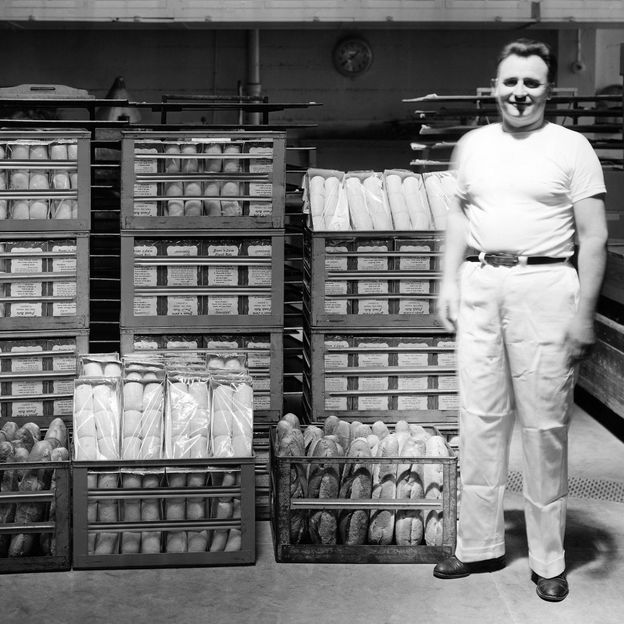
Boudin Bakery in San Francisco claims to have maintained its sourdough starter since 1849 (Credit: Boudin Bakery)
"The second documented case that comes with lab books and everything, there is a German starter culture producer called Böcker," Gänzle explained. "They have, at least in Germany and in surrounding countries, pretty much the best reputation of selling a good sourdough starter culture. And they've been propagating their sourdough, I think, since 1906. And they have documentation that this sourdough has been continuously propagated over at least 100 years now. It's almost 120."
But one of the most interesting tales of sourdough lore comes from a very unlikely place. In his search for the origins of sourdough, author Eric Pallant discovered a church in Syria that makes a fascinating claim.
"The Nestorians, who are in Assyria, insist, based on their scriptures, that their sourdough actually comes from the tears of Christ on the cross and his blood after he's been stabbed by the Romans. John the Baptist captured [that blood and tears] and [made] a sourdough starter. [From there] the Apostles handed out [that starter], and it is the Eucharist that's still being using by this church [in Syria]," said Pallant. "So, when Jesus says, my body is bread, and my blood is wine – which are both products of fermentation – the Nestorians insist it really is!"
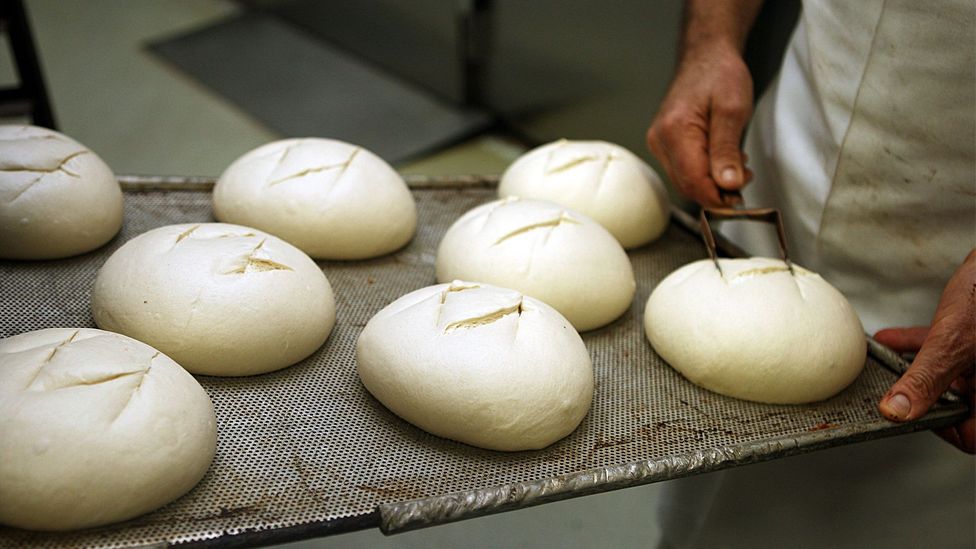
Sourdough loaves are being prepped for the oven at Boudin Bakery in San Francisco (Credit: San Francisco Chronicle/Hearst Newspapers/Getty Images)
Was the "Holy Grail" of historic starters then hidden in plain sight all along, inside a church in Syria, backslopped thousands of times and given as holy communion over and over and over? It's unlikely. And whether or not it provides "everlasting life" to the pious churchgoers who consume it, the starter might have achieved a level of immortality – in the form of water, flour, yeast and bacteria – that rivals any story about the Fountain of Youth or the Cup of Christ.
So, who has the oldest starter in the world? The short, scientific answer is nobody. If you're a stickler for documentation, though, Böcker in Germany, Boudin in San Francisco, and possibly Kimuraya bakery in Japan have claims to the prize. Anecdotally, the oldest, maybe hardest to believe starter might have traces of DNA from Jesus Christ himself. But if microbiologists ever find a novel way to verify the mythological claims of starter origins, the Puratos Library in Belgium might have to build a bigger wing for the oldest, rarest mothers on Earth.
BBC.com's World's Table "smashes the kitchen ceiling" by changing the way the world thinks about food, through the past, present and future.
---
Join more than three million BBC Travel fans by liking us on Facebook, or follow us on Twitter and Instagram.
If you liked this story, sign up for the weekly bbc.com features newsletter called "The Essential List". A handpicked selection of stories from BBC Future, Culture, Worklife and Travel, delivered to your inbox every Friday.
"bread" - Google News
July 12, 2022 at 03:07AM
https://ift.tt/2Dt36hk
The world's oldest sourdough? - BBC
"bread" - Google News
https://ift.tt/bm7FyVD
https://ift.tt/Mwi2FkG
Bagikan Berita Ini














0 Response to "The world's oldest sourdough? - BBC"
Post a Comment